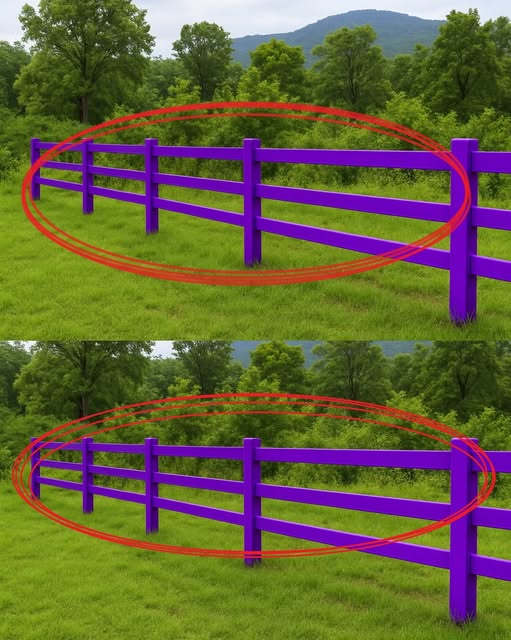Have you ever been walking through a quiet neighborhood or maybe down a peaceful country trail and noticed something unusual — a fence painted bright purple? Not the standard brown, white, or gray you’d expect, but a deep, almost grape-juice purple that looks like it came straight out of a crayon box. At first, your brain might shrug it off — maybe the owner just has a quirky taste in colors or got a discount on purple paint. But actually, there’s a reason behind it, and it’s not about aesthetics or creativity. A purple fence — or purple paint on trees or posts — sends a clear message: no trespassing.
It might sound strange at first. Why purple? Why not red, the universal color for warning? Or orange, which screams caution? Why not just use a good old-fashioned “Keep Out” sign? The answer lies in practicality. In many rural areas, particularly across the southern and midwestern United States, purple paint is a legal code for private property. In fact, several states — including Texas, North Carolina, and Illinois — have passed “Purple Paint Laws.” These laws recognize purple markings as an official substitute for “No Trespassing” signs. Instead of putting up dozens of metal or wooden signs that can fade, blow away, or get stolen, landowners simply paint a purple line — durable, weather-resistant, and instantly recognizable to those who know what it means.
But here’s where it gets interesting — not just any splash of purple paint will do. The law outlines clear rules about how to paint these warnings so there’s no confusion. For one, the stripes must be vertical, not random strokes or sideways lines. Vertical stripes are deliberate — they tell passersby that the paint is not accidental. The marks must also be of a specific size, generally at least one inch wide and eight inches long, large enough to catch the eye from several feet away. Too small, and it looks like graffiti. Too large, and it might seem like an art project rather than a warning.
Then there’s placement. Those purple marks must be painted three to five feet off the ground — the perfect range for visibility. Too low, and they’ll be hidden by tall grass or brush; too high, and most people won’t notice. The goal is simple: make sure anyone walking nearby sees the paint right at eye level, even if they’re not actively looking for it. And it’s not just about one mark or one post — consistency matters. To properly define private property, landowners typically apply these purple stripes every hundred feet or so, ensuring that no matter where someone might enter, they’ll encounter a visible warning before stepping over the line.
However, before you grab a paintbrush, there’s something important to know: purple paint laws aren’t universal. Some states fully recognize them, others only partially, and in a few places, they carry no legal meaning at all. Painting your fence purple in a state that doesn’t enforce the rule might only confuse people — or worse, make your property look eccentric without offering any legal protection. So, before you start marking your property, it’s always wise to check your local and state regulations to ensure your purple paint actually has legal backing.
Still, the idea behind it makes a lot of sense. The color purple stands out in nature — it’s uncommon enough to grab attention, yet not aggressive like red. Most people don’t expect to see it on a fence or tree trunk, so when they do, it immediately raises curiosity and caution. The beauty of the system lies in its simplicity: no bulky metal signs, no need for words, no maintenance — just a splash of color that quietly but firmly says, this land is private, please stay away.
And while it might seem like an odd rural quirk, it’s actually quite effective. Hikers, hunters, and campers who frequent areas where the law applies quickly learn to recognize purple as the color of boundaries. In some regions, the same code even extends beyond fences — you’ll see purple bands painted on trees, wooden stakes, or even rocks lining property edges. It’s subtle but powerful, a silent communication between landowners and the public.
So, the next time you’re walking through the countryside or exploring a forest trail and your eyes catch a streak of purple on a post or tree trunk, don’t ignore it. It’s not a creative expression or a random splash of paint — it’s a message. The land beyond that mark is off-limits unless you have permission to enter. It’s a quiet, visual way of saying what a sign would: private property — no trespassing.
It might sound almost whimsical — a secret color code hidden in plain sight — but it’s an ingenious solution that saves time, money, and confusion. The purple fence may not be pretty, but it’s practical, protective, and legally sound in many places. So next time you see that curious streak of purple, stop and appreciate it for what it is: not just an unusual color choice, but a symbol of boundaries, communication, and respect for private land.
